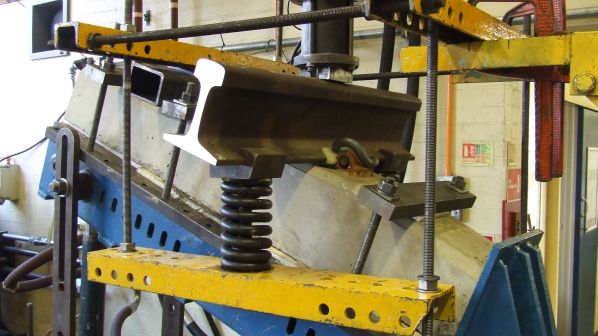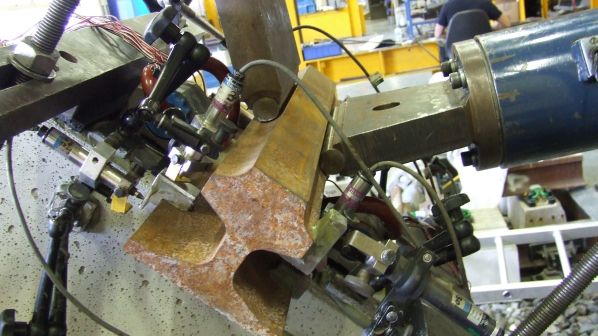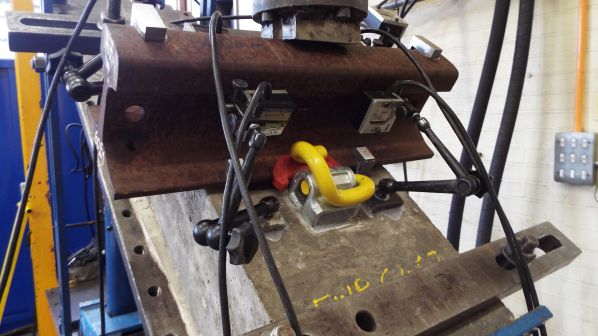RAIL fastening systems occupy a unique position in the list of components that make up a modern railway track structure. At first glance they are a “commodity” product: mass produced parts of which thousands are used in every kilometre of track. But at the same time, they are safety critical elements which must work in a demanding environment.
Fastenings provide the crucial interface between the rails and the supporting structure. Under the severe and often unpredictable dynamic loading from passing trains they are mechanical engineering elements in a civil engineers’ world.
Fastenings also affect vibration isolation, signalling track circuits, stray current protection and many other aspects of the system performance.
It must be possible to leave them in the track for years with little or no maintenance and yet, when the time comes to change the rails or adjust the track geometry, it must be possible to unfasten and re-fasten the rails with ease.
Knowing all of this, track designers and maintainers face the question of how to be sure that these requirements will be met before committing to the use of a particular type of fastening and building hundreds of kilometres of track. The answer is to make use of technical specifications and test regimes established in the industry and constantly under review as track technology advances.
Most railway permanent way departments base their rail fastening specifications on one of three established sets of criteria developed in Europe, the United States, and Japan.


In Europe, work began in the late 1980s to reconcile requirements developed in parallel by a number of major railways. The work began at the International Union of Railways (UIC) but was eventually established under the European Standards Committee (CEN) and was finally published in 2002 as a set of standards applicable to most main line, high-speed and suburban railways. Those standards were updated in 2012 and are currently being reviewed again, taking account of developments in areas such as ballastless track, plastic sleepers and urban railways. CEN has recently published a technical report (CEN TR/17320:2019) which summarises the history of this development and explains the background to many of the test requirements which appear in the standards.
In the United States, recommended practice for acceptance testing of rail fastenings is contained in the American Railway Engineering and Maintenance-of-way Association (Arema) Manual for Railway Engineering. Specific tests are set out which are appropriate for heavy-haul freight railways and some advice is given for other applications. At the other end of the scale, fastenings for ballastless track in urban transit systems in the United States are generally tested using methods derived from specifications written for specific networks in the 1980s, copied and modified by design consultants to suit each generation of new projects.
Finally, in Japan, rail fastening design and test requirements were developed as the country invested in new infrastructure with the introduction of the Shinkansen high-speed network and these requirements have been developed and expanded more recently by the Railway Technical and Research Institute (RTRI) to cover all kinds of track configuration.
In many other countries, current specifications for fastenings can be traced back to one of these three sources. In most respects, the three approaches lead to similar conclusions. In each case, a central part of the test regime is a repeated load test in which a short piece of rail is fastened to half a sleeper and a load applied to the rail to simulate the action of a passing train in a curve. The loads which are applied are derived from measurements made in track under traffic. The performance is assessed not only by observation - for example, has anything broken during the test? - but also by measuring key parameters before and after the test to indicate the rate of deterioration.
Similarities
The three photographs show this test according to European, American and Japanese requirements. The similarities are clear: in every case a cyclic load with both vertical and lateral components is applied to the rail. In the European test the force is just applied by one actuator; in the American test the angle is less severe but an additional opposing force is applied by coil springs under the rail foot; and in the Japanese test, two actuators are used, applying alternating forces from one side of the rail and then the other.
In every case, it tends to be the ability to withstand the lateral forces which, ultimately, determines the durability of the fastening system. That creates something of a problem, because the magnitude of the lateral forces applied to the rail by passing wheels is dependent not only on the design of the track (curve radius, super-elevation, etc) but on the design of the train (wheel profile, bogie yaw stiffness, etc).
In most cases the track is designed and built with the intention of safely operating all kinds of rolling stock - some of which may not even exist on the day that the track is built! It is now possible to predict quite closely the lateral forces that will be applied by a given type of train on a given curve, but in the case of the rail fastening system that does not solve the problem. When writing standards and specifications for general use, there is still a need to assess the whole range of possible loading actions which could occur.
The differences between these test regimes are partly technical, but that is not the whole story. The European standards are, indeed, standards - developed and vetted by CEN and the national standards bodies of countries which are members of CEN. They are written so that, if required, they can be made mandatory by national or international regulations but also to make them suitable for reference in commercial contracts. It should be clear that a product which passes each of the tests complies with the standard and is, therefore, safe to use within the stated scope of that standard.
The tests set out in the Arema Manual for Railway Engineering are no less rigorous, but they are presented as recommended practice, not as mandatory requirements. Some engineering judgement is needed to decide whether one recommendation may take precedence over other conflicting advice for a particular application. This is a good approach for railways with knowledgeable engineering teams but has been known to cause problems when clients in international markets simply insert a requirement to “comply with Arema standards” into their contracts.
The American transit specifications also work well in the market for which they were developed, but for broader applications they can become over-prescriptive. These specifications were originally intended to ensure a level playing field for suppliers competing with similar products for projects for which most of the design work had already been completed. The same specifications cannot be used within the employer’s requirements for a design and build contract as they would restrict the contractor’s ability to design.
Looking around the world today, we see many new railway projects in places where there is no long history of track engineering such as heavy-haul projects in Africa, high-speed railways in the Middle East, or mass transit systems in South America. As international consultants and contractors move into these areas, there is a growing need for international agreement on technical standards - not only for rail fastenings, but throughout the engineered system which we call a railway. In 2012 the International Standards Organisation (ISO) established a technical committee on railway applications (TC269), which is beginning to pick up this work.
An ISO working group is currently developing common standards for rail fastenings regarding terminology and test procedures. The working group is bringing together experts from several European countries as well as China, Japan and South Korea. Work is now well advanced, and it is expected that the eight parts of the new international standard, ISO 22074, will be published in 2020. That still leaves big questions about just what level of performance and durability is appropriate for each project, but it will, at least, mean that the playing field upon which performance is measured will be a little more level.
The view from Pandrol - Steve Cox, Pandrol’s technical director
STANDARDS are helpful for launching new products on the market because once compliance is demonstrated, the solution becomes widely accepted as feasible. Suppliers must stay on top of changes in the standards, but these are generally small and incremental.
Arema holds meetings every year at which in principle changes can be proposed and voted on, but because it is done by committee things happen rather slowly. CEN standards change in discrete jumps typically perhaps every seven or eight years when there is a revision. But the tests have been reasonably stable and the jumps small. The biggest change was probably the 2012 revisions to the CEN standards.
There is nothing really in current tests which impacts or changes the way we work - that change really came about 20 years ago with the introduction of the CEN standards.
However, what is changing slowly, as mentioned in the article, is that many places around the world - Brazil and China are good examples - that are not bound by the CEN standards are nevertheless using them either as their entire standard or as the basis for their test standard with usually small variations.
The issue with that is that in some cases the standards are not published in their first language and to date the standards have not - correctly since they are standards - contained any background or explanatory notes. In some cases, the spirit or the literal interpretation of tests has not been understood.
A useful development of the past few years concerns the manner in which test method requirements are set out. While in most cases the tests have remained the same, the way test methods and requirements are set out have become more precise and concise. This has certainly helped suppliers and I expect the new note TR/17320:2019 will continue this trend.
The development of the future ISO standard could also have a big impact, but it will depend on its final formulation and how it is set out. I think it quite likely that we will see something similar to the current Australian standard which allows suppliers to demonstrate suitability by applying something similar to either the Arema standard or CEN standard.
While this will help to reduce the number of different tests that need to be applied, the effect is unlikely to be huge, because for the last 20 years railways without their own standard have been increasingly looking to the CEN standard, and that trend will continue. A CEN-based option within the ISO standard would encourage that further.
The view from Vossloh
VOSSLOH has been designing and supplying rail fastenings since 1950. Today, the company exports rail fastenings around the world and its products must meet the requirements, specifications and standards of a variety of railways, metros and light rail operators, and increasingly the different standards around the world.
“In the beginning, we supplied fastenings according to national requirements, but today all our product development follows the European standards (EN) or other specific standards,” says Mr Winfried Bösterling, global executive vice-president, innovation and R&D, with Vossloh Fastening Systems. “For North America, we follow the Arema standards, and in Japan the RTRI standards. But there are a lot more standards, specifications and guidelines than this. Up to now China has its own standard for the high-speed network, and the Chinese are working in the ISO fastening systems working group. In Russia and the Commonwealth of Independent States (CIS), Gost is the guiding standard, where rail fastenings have to be able to withstand the effects of rail temperatures ranging from -60oC to +60oC. In all these areas they are establishing specific requirements which we have to follow which, in their diversity, is a challenge.”
Bösterling says the European standard has a long history and is also used by railways outside Europe. In some parts of the world, such as South America, there is less conformity with some railways preferring European standards while others adopt Arema standards. Having several standards to choose from can sometimes lead to confusion. For example, there are instances of metros requesting rail fastenings according to Arema standards which are aimed at heavy-haul railways which could result in the supply of over-engineered fastenings.
“Arema has a 35-tonne axleload as a standard, so it would make no sense to use this in Europe for conventional track, for example,” Bösterling says. “In the end, this has a commercial aspect regarding pricing, so we speak about optimised rail fastening systems.”
Ms Nicole Wiethoff, vice-president, system technology, with Vossloh Fastening Systems, believes the new ISO common standards for rail fastenings regarding terminology and test procedures, which will be published next year, will be a good first step. “Having a unified testing method will enable us to replicate tests and compare test results,” Wiethoff told IRJ.
“It will be another step towards having a single rail market for fastenings, but for us it will be a first step,” Bösterling says. “This work is never finished because there will always be new techniques and requirements, for example because of digitalisation or global warming, and the need to reduce noise and vibration especially on metros.”

